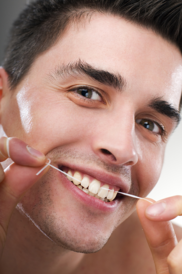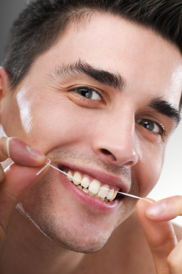Rinsing, Flossing, or Brushing? What Comes First?


The choice is pretty simple: you can brush first and risk jamming food bits between your teeth and below your gum line, or you can use water and cheek power to create a tidal wave that will flush bacteria-laden bits out of your mouth and down the drain. Add a bit of your favorite commercial mouthwash, peroxide, or a dentist-approved anti-gingivitis herbal remedy to your rinse water and you’ll create another margin of safety once the brush hits your mouth.
 But before you brush, take the small extra step of soaking the bristly head in peroxide before dabbing on the toothpaste. If your brush is doing its job, bacteria will be camping out in its forest of bristles. A five-second soaking of the bristles in peroxide will stop those would-be hiker bugs in their tracks and keep your mouth and teeth healthy.
But before you brush, take the small extra step of soaking the bristly head in peroxide before dabbing on the toothpaste. If your brush is doing its job, bacteria will be camping out in its forest of bristles. A five-second soaking of the bristles in peroxide will stop those would-be hiker bugs in their tracks and keep your mouth and teeth healthy.
Now on to flossing. Do it after brushing to reduce the risk of transferring bacterial matter to your other teeth. Take care as well to you use a fresh section of floss for every tooth junction. Then rinse your mouth again (using cheek power) to remove any particles the flossing will have dislodged.
So that’s it. Rinsing comes first, brushing second, and flossing third – followed by a quick finishing rinse with a quality mouthwash. That simple extra step will ensure you’ve done the best job you possibly can in caring for your teeth. Come on! It only takes three minutes!


